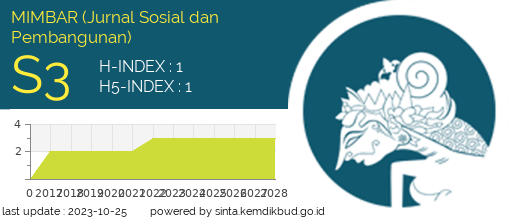Author Guideline
- The article must be original to the research report, related to social and development, and has not been published or submitted for publication elsewhere.
- The article is typed in Ms-Word for Windows, double-spaced format in A4 paper size, the font being used is Verdana size 9.5 without a word fragment (hard-hyphenation), the length of the article is between 5500-6500 words.
- The article is written in Indonesian and English in accordance with the applied language rules.
- The title of the article should be written specifically and effectively, not more than 11 words.
- Author identity must contain full name without title, affiliation/institution, country, and e-mail address for correspondance author. examples:
1 Evi Fazriah, 1 Nino Agus Kuswanto, 2 Eep Saefulah Imran
1 Fakultas Komunikasi, Universitas Kebangsaan Malaysia, Malaysia
2 Fakultas Ilmu Sosial dan Politik, Universitas Islam Indonesia, Indonesia
correspondance author: * eep.saefulahimran@unisba.ac.id - The abstract of the article is written in English and contains 130 to 150 words, followed by 3 keywords. The English abstract is written in the present tense.
Keywords: first keyword; second keyword; third keyword. - The article is in the form of research report in the following order. In writing the article, the author must avoid the use of dot points, alphabetical order, or numbering as follows.
1. …
2….
3….
Should be written as follows: (1) ....; (2) ... .; (3) ....
The article is written in essay form, so there is no numeric or alphabetic format that separates between chapters /sections, or to mark the chapter/new part. Tables and pictures/graphics are only placed in the discussion section. Conclusions are not specified in the points, but in the form of paragraphs. - Authors should attach a curriculum vitae (CV) containing full name, place and date of birth, address of the agency or a private address for correspondence (street name, city, zip code, e-mail, phone, and fax).
-
Tables
Tables in the article are sequentially numbered (1, 2, and so on). Each table in the article must contain a brief title in order to describe its correlation to the article. The table title is put above the table and written in bold. -
Pictures
Every illustration in a form of diagram or photo is categorized as pictures and must be sequentially numbered (1, 2, 3, and so on). Each picture contains a brief title explaining its correlation to the article. The title of the picture is put under the diagram or photo and written in italic.
The article is submitted to our online journal through address http://ejournal.unisba.ac.id/index.php/mimbar. The submitted article must follow the author guidelines. - The articles that have passed the peer review process and been accepted, then, must be translated into English.
- The editorial team has an authority to edit the article without changing the substance of the article and the author’s thoughts.
- The editorial team will not return the articles which are not accepted.
- For submissions to issues published from 2022 onwards, the MIMBAR : Jurnal Sosial dan Pembangunan uses the American Psychological Association 7th edition (APA 7th) in the References at the end of the manuscript. Cite only items that you have read and written on endnote. Please use Reference Manager Applications with Mendeley. Use other published articles in the same journal as models. All publications cited in the text should be included in the References section and arranged alphabetically. Example:
Ameyaw EE., Chan APC and Owusu-Manu DG. (2020). A survey of critical success factors for attracting private sector participation in water supply projects in developing countries, Journal of Facilities Management, 10.1108/JFM-06-2016-0027, 15, 1, (35-61).
Anandini, F. (2020). Identification of Prospects for Sustainability of Community Based Clean Water Supply Activities after the Water and Sanitation for Low-Income Community-2 Program Ends (Case study: Bogor Regency). Journal of Regional and City Planning, Vol 23/2 December 2011.
Braimah, I., Amponsah, O., Asibey, M.O. (2021). The effectiveness of the local management systems of rural water facilities for sustainable service delivery: a case study of the Sekyere East District, Ghana. Sustain. Water Resour. Manag. (2021) 2:405–418. DOI 10.1007/s40899-016-0070-7
Cahyaningrum, D. (2019). Community Empowerment Based Local Wisdom In Tourism Of Bajo Community, Wakatobi. International Journal of Scientific & Technology Research. Volume 6 - Issue 11, November 2017 Edition.
Chaerunnissa, C. (2020). Community Participation in the Community-Based Water Supply and Sanitation Provision Program in Brebes Regency. POLITICS, Vol. 5, No.2, October 2015.
Daley, K., Castleden, H., Jamieson, R., Furgal, C., & Ell, L. (2018). Water systems, sanitation, and public health risks in remote communities: Inuit resident perspectives from the Canadian Arctic. Social Science & Medicine. Volume 135, June 2015, Pages 124-132.
SUBMISSION PREPARATION CHECKLIST
As part of the submission process, authors are required to check off their submission's compliance with all of the following items, and submissions may be returned to authors that do not adhere to these guidelines.
- The submission has not been previously published, nor is it before another journal for consideration (or an explanation has been provided in Comments to the Editor).
- The submission file is in Microsoft Word, or RTF document file format.
- Where available, URLs for the references have been provided.
- The text adheres to the stylistic and bibliographic requirements outlined in the Author Guidelines, which is found in About the Journal.
- If submitting to a peer-reviewed section of the journal, the instructions in Ensuring a Blind Review have been followed.













